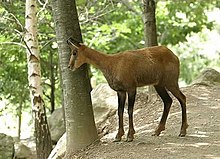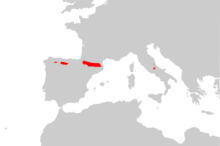Pyrenean chamois: Difference between revisions
BhagyaMani (talk | contribs) →top: edited ref |
No edit summary |
||
| Line 4: | Line 4: | ||
| status = LC |
| status = LC |
||
| status_system = IUCN3.1 |
| status_system = IUCN3.1 |
||
| status_ref = <ref name=iucn>{{cite iucn |title=''Rupicapra pyrenaica'' |author=Herrero, J. |author2=Lovari, S. |author3=Nores, C. |author4=Toigo, C. |date= |
| status_ref = <ref name=iucn>{{cite iucn |title=''Rupicapra pyrenaica'' |author=Herrero, J. |author2=Lovari, S. |author3=Nores, C. |author4=Toigo, C. |date=2022 |page=e.T19771A217715455|doi=doi.org/10.2305/IUCN.UK.2022-1.RLTS.T19771A217715455.en|access-date=21 July 2022}}</ref> |
||
| image = Isard des pyrenees bigorre 2003.jpg |
| image = Isard des pyrenees bigorre 2003.jpg |
||
| taxon = Rupicapra pyrenaica |
| taxon = Rupicapra pyrenaica |
||
| authority = ([[Charles Lucien Bonaparte|Bonaparte]], 1845) |
| authority = ([[Charles Lucien Bonaparte|Bonaparte]], 1845) |
||
| range_map = Rupicapra pyrenaica range Map.png |
| range_map = Rupicapra pyrenaica range Map.png |
||
| range_map_caption = Distribution of Pyrenean chamois |
| range_map_caption = Distribution of Pyrenean chamois |
||
}} |
}} |
||
The '''Pyrenean chamois''' (''Rupicapra pyrenaica'') is a [[goat-antelope]] that lives in the [[Pyrenees]] |
The '''Pyrenean chamois''' (''Rupicapra pyrenaica'') is a [[goat-antelope]] that lives in the [[Pyrenees]] & [[Cantabrian Mountains]] of [[Spain]], [[France]] & [[Andorra]], and the [[Apennine Mountains]] of central [[Italy]]. It is one of the two species of the genus ''Rupicapra'', the other being the [[chamois]], ''Rupicapra rupicapra''.<ref name=iucn></ref> |
||
==Names== |
==Names== |
||
| Line 24: | Line 24: | ||
*[[Aragonese language|Aragonese]]: ''sarrio'', ''chizardo'' |
*[[Aragonese language|Aragonese]]: ''sarrio'', ''chizardo'' |
||
== |
== Subspecies == |
||
| ⚫ | Up to 80 cm tall, its summer coat is a ruddy brown; in winter, it is black or brown, with darker patches around the eyes. Both males and females have backward-hooked [[Horn (anatomy)|horn]]s up to 20 cm in length. They browse on [[grass]], [[lichen]]s and buds of trees. [[Sure-footed]] and agile, they are found on any elevation up to 3000 m. |
||
| ⚫ | |||
| ⚫ | Like other species of chamois, it was hunted almost to [[extinction]], especially in the 1940s, for the production of [[chamois leather]]. The population has since recovered, and in |
||
==Subspecies== |
|||
[[File:Rupicapra pyrenaica ornata 5.JPG|''Rupicapra pyrenaica ornata''|thumb|200px]] |
[[File:Rupicapra pyrenaica ornata 5.JPG|''Rupicapra pyrenaica ornata''|thumb|200px]] |
||
| Line 36: | Line 30: | ||
:*''[[Cantabrian chamois|R. p. parva]]'' (Cantabrian chamois): Spain |
:*''[[Cantabrian chamois|R. p. parva]]'' (Cantabrian chamois): Spain |
||
:*''[[R. p. ornata]]'' (Abruzzo chamois): Central and southern Italy |
:*''[[R. p. ornata]]'' (Abruzzo chamois): Central and southern Italy |
||
==Description== |
|||
| ⚫ | Up to 80 cm tall, its summer coat is a ruddy brown; in winter, it is black or brown, with darker patches around the eyes. Both males and females have backward-hooked [[Horn (anatomy)|horn]]s up to 20 cm in length. They browse on [[grass]], [[lichen]]s and buds of trees. [[Sure-footed]] and agile, they are found on any elevation up to 3000 m. |
||
| ⚫ | |||
| ⚫ | Like other species of chamois, it was hunted almost to [[extinction]], especially in the 1940s, for the production of [[chamois leather]]. The population has since recovered, and in 2022 was estimated to be about 50,000 mature individuals.<ref>Pérez-Barbería, F. J., García-González, R. (2004). [https://web.archive.org/web/20051229232203/http://www.vertebradosibericos.org/mamiferos/pdf/ruppyr.pdf "Rebeco – Rupicapra pyrenaica."] Enciclopedia Virtual de los Vertebrados Españoles. Carrascal, L. M., Salvador, A. (Eds.). Museo Nacional de Ciencias Naturales. Madrid, Spain.</ref><ref name=iucn></ref> |
||
{{Clear|left}} |
{{Clear|left}} |
||
Revision as of 18:17, 21 July 2022
| Pyrenean chamois | |
|---|---|

| |
| Scientific classification | |
| Domain: | Eukaryota |
| Kingdom: | Animalia |
| Phylum: | Chordata |
| Class: | Mammalia |
| Order: | Artiodactyla |
| Family: | Bovidae |
| Subfamily: | Caprinae |
| Tribe: | Caprini |
| Genus: | Rupicapra |
| Species: | R. pyrenaica
|
| Binomial name | |
| Rupicapra pyrenaica (Bonaparte, 1845)
| |

| |
| Distribution of Pyrenean chamois | |
The Pyrenean chamois (Rupicapra pyrenaica) is a goat-antelope that lives in the Pyrenees & Cantabrian Mountains of Spain, France & Andorra, and the Apennine Mountains of central Italy. It is one of the two species of the genus Rupicapra, the other being the chamois, Rupicapra rupicapra.[1]
Names
- Spanish: rebeco, gamuza
- French: izard/isard
- Galician: rebezo
- Asturian: rebezu/robezu
- Catalan: isard
- Italian: camoscio dei Pirenei, camoscio appenninico
- Basque: pirinioetako sarrioa
- Aragonese: sarrio, chizardo
Subspecies

- R. p. pyrenaica (Pyrenean chamois): France and Spain
- R. p. parva (Cantabrian chamois): Spain
- R. p. ornata (Abruzzo chamois): Central and southern Italy
Description
Up to 80 cm tall, its summer coat is a ruddy brown; in winter, it is black or brown, with darker patches around the eyes. Both males and females have backward-hooked horns up to 20 cm in length. They browse on grass, lichens and buds of trees. Sure-footed and agile, they are found on any elevation up to 3000 m.
Conservation
Like other species of chamois, it was hunted almost to extinction, especially in the 1940s, for the production of chamois leather. The population has since recovered, and in 2022 was estimated to be about 50,000 mature individuals.[2][1]
References
- ^ a b c Herrero, J.; Lovari, S.; Nores, C.; Toigo, C. (2022). "Rupicapra pyrenaica". IUCN Red List of Threatened Species. 2022: e.T19771A217715455. doi:doi.org/10.2305/IUCN.UK.2022-1.RLTS.T19771A217715455.en. Retrieved 21 July 2022.
{{cite journal}}: Check|doi=value (help) - ^ Pérez-Barbería, F. J., García-González, R. (2004). "Rebeco – Rupicapra pyrenaica." Enciclopedia Virtual de los Vertebrados Españoles. Carrascal, L. M., Salvador, A. (Eds.). Museo Nacional de Ciencias Naturales. Madrid, Spain.
- Haack, M. 2002. Rupicapra pyrenaica. Animal Diversity Web. Accessed February 20, 2006.
- Pérez, T., Albornoz, J. & Domínguez, A. (2002). Phylogeography of chamois (Rupicapra spp.) inferred from microsatellites. Mol Phylogenet Evol. 25, 524–534.

